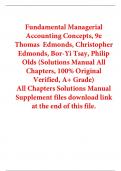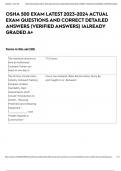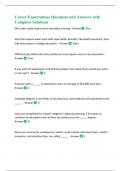Fundamental Managerial
Accounting Concepts, 9e
Thomas Edmonds, Christopher
Edmonds, Bor-Yi Tsay, Philip
Olds (Solutions Manual All
Chapters, 100% Original
Verified, A+ Grade)
All Chapters Solutions Manual
Supplement files download link
at the end of this file.
,Chapter 01 - Management Accounting and Corporate Governance
Teaching Notes for Chapter 1
Managerial accounting requires teaching methods different from those used in financial
accounting. In the introductory financial accounting course, instructors teach students
about accounting standards. A primary goal in teaching managerial accounting is to
develop students’ conditional assessment skills (critical-thinking skills). For example,
in a later chapter, students are frequently confused by the fact that, in different
situations, a given cost can be classified as fixed or variable, direct or indirect, relevant
or not relevant. The salary cost of store managers may be fixed with respect to the
number of customers that enter their stores. However, managers’ salary cost is variable
relative to the number of stores a company operates. A manager’s salary cost is directly
traceable to a particular store but not traceable to a sale occurring in the store. Students
must learn to assess the conditions that determine cost classification. Chapter 1 offers
the first opportunity to develop the students’ conditional assessment skills. Here,
students learn that depreciation can be classified as an asset or an expense, depending on
certain conditions. If a depreciable asset is used to produce inventory, the depreciation
cost will first be classified as an asset (inventory) and later as an expense (cost of goods
sold). If the depreciable asset is used to support selling and administrative activities,
depreciation will be reported directly on the income statement as depreciation expense.
Students typically enter managerial accounting with rigid ideas about expense
recognition. In financial accounting they learned that depreciation and employee
compensation costs are expensed directly on the income statement. The idea that
depreciation related to manufacturing equipment and wages of production workers will
pass through an inventory account before being expensed as cost of goods sold is
contrary to their existing knowledge base. Expanding that knowledge base requires a
significant commitment of teaching time. Your students are developing their analytical
skills. They are learning how to assess the conditions that influence cost classification.
This type of learning requires more time than merely memorizing definitions. If you
sometimes feel that progress is too slow, remember that you are building a foundation
upon which subsequent learning will rest. There is no more important teaching task than
helping students form a sound conceptual framework. We recommend using
approximately three hours of class time for Chapter 1.
1-1
Copyright © 2020 McGraw-Hill Education. All rights reserved. No reproduction or distribution without the prior written consent of
McGraw-Hill Education.
,Chapter 01 - Management Accounting and Corporate Governance
Detailed Outline of a Lesson Plan for Chapter 1
A comprehensive lesson plan for the first day of class begins in the Introduction to this manual. Please
read it before implementing steps II–VIII of the following lesson plan.
I. Distinguish between managerial and financial accounting. The best way to
differentiate between managerial and financial accounting is to highlight
differences where they occur in the subject matter throughout the course. For
example, when using estimated data in a decision-making context, point out that
managerial accounting is future-oriented rather than historically based. A long
monologue about the differences between financial and managerial accounting
will only bore your students. In a brief introduction to this topic, you might
discuss the information needs for internal users (managers) to plan, direct, and
control. The information needed by a manager depends on his/her position in the
organization and the particular decision facing the manager. If you want to spend
more time on the topic, Exercise 1-1A from the end-of-chapter materials in the
text might be an appropriate in-class activity at this point.
II. Use Demonstration Problem 1-1 as a problem-based learning exercise. (See
the introduction to this manual for details about problem-based learning.)
III. After giving the students a few minutes to digest the problem and formulate
solutions, engage them in some form of collaborative learning experience.
IV. Introduce the concept of product costing by providing the solution to
requirement a of Demonstration Problem 1-1.
V. Continuing Demonstration Problem 1-1, determine the cost per unit and the
sales price using a cost-plus pricing strategy.
VI. Show how product costs are expensed through cost of goods sold.
VII. Introduce the cost category of selling, general, and administrative costs
(SG&A costs).
VIII. Use Problem 1-19A as an in-class reinforcement exercise.
IX. Copy and distribute Demonstration Problem 1-2. Demonstration Problem 1-2
expands the classification concepts introduced in Demonstration Problem 1-1 to
include accounting for the depreciation of manufacturing equipment. Explain
that depreciation on manufacturing facilities and equipment is a product cost.
Point out that the entry to record depreciation on manufacturing equipment
represents an asset exchange transaction. The book value of manufacturing
equipment decreases, and the balance in the Inventory account increases.
Students are so accustomed to the idea that depreciation is an expense, they are
1-2
Copyright © 2020 McGraw-Hill Education. All rights reserved. No reproduction or distribution without the prior written consent of
McGraw-Hill Education.
, Chapter 01 - Management Accounting and Corporate Governance
not likely to grasp the product cost concept until they work a problem. After your
explanation, assign Demonstration Problem 1-2 to students and have them
attempt to work the problem. Students should be able to work the problem with
minimal help. Walk around the room; if you find that students are having
trouble, help as needed.
If you desire further reinforcement of product versus SG&A cost classifications,
see Problem 1-20A or 1-20B. Students may need help getting started with these
problems.
X. Discuss the importance of product and period costing in financial
statements. Students are interested in how product costing affects real-world
decision making. After showing them how the classification of costs as product
versus selling, general, and administrative can affect the amounts reported in a
company’s balance sheet and income statement, we discuss how the amounts
reported in the financial statements can affect business decisions. Specifically,
we discuss the implications for acquiring capital or debt, the potential effect on
executive compensation, and the impact on income taxes. To address these
issues, we suggest you use Problem 1-21A as a demonstration problem. Then,
you may wish to use Problem 1-21B as a homework problem.
XI. Discuss managerial versus financial treatment of upstream, midstream, and
downstream costs in manufacturing companies. This can eliminate the need
for separate reports for internal and external financial reporting. Managers may
fail to use upstream or downstream costs when calculating sales price or product
profitability. Use Demonstration Problem 1-3 to introduce this concept.
XII. The chapter provides a brief introduction to total quality management
(TQM), activity-based management (ABM), and value chain analysis. Each
of these topics is covered in more depth in later chapters of the text. If you are
running short of time, you may minimize the time you allocate to these subjects.
If you wish to cover these topics, we suggest that you use a problem from the A
Set of the end-of-chapter materials, like Problem 1-29A on value chain analysis,
in the text as a demonstration problem. Then you may wish to use Problem 1-
29B as a homework problem.
1-3
Copyright © 2020 McGraw-Hill Education. All rights reserved. No reproduction or distribution without the prior written consent of
McGraw-Hill Education.






